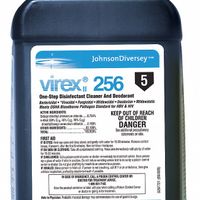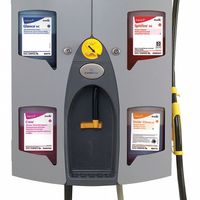Call +(254) 703 030 000 / 751 483 999 / 721 704 777
- Home
- Cleaning And Janitorial
- Cleaning Chemicals
- Dilution Control Systems
.....Read More
Frequently Asked Questions
What is a dilution control system?
A dilution control system is a mechanism used to accurately mix and dispense concentrated chemicals with water to achieve a desired concentration for various applications. These systems are commonly used in industries such as cleaning, sanitation, and chemical manufacturing to ensure safety, efficiency, and cost-effectiveness.
The primary components of a dilution control system include a dispenser unit, which is connected to a water source and the concentrated chemical container. The system uses a metering device, such as a venturi valve or a peristaltic pump, to control the flow rate of the concentrate and water, ensuring the correct dilution ratio. Some systems are equipped with multiple channels to handle different chemicals simultaneously.
Key benefits of dilution control systems include:
1. **Accuracy**: They provide precise control over the dilution ratio, ensuring consistent results and optimal performance of the chemical solution.
2. **Safety**: By minimizing direct contact with concentrated chemicals, these systems reduce the risk of spills, exposure, and accidents for users.
3. **Cost-Effectiveness**: They help in reducing waste by using only the necessary amount of concentrate, leading to cost savings on chemical purchases.
4. **Environmental Impact**: Proper dilution reduces the environmental footprint by minimizing chemical waste and ensuring that only the required amount of chemical is used.
5. **Convenience**: These systems simplify the process of preparing cleaning solutions, saving time and effort for users.
Overall, dilution control systems are essential tools for industries that rely on chemical solutions, providing a reliable and efficient way to manage chemical usage while ensuring safety and compliance with regulatory standards.
How do dilution control systems work?
Dilution control systems are designed to accurately mix concentrated cleaning chemicals with water to achieve the desired solution strength for various cleaning tasks. These systems ensure safety, cost-effectiveness, and environmental sustainability by minimizing chemical waste and exposure.
The core components of a dilution control system include a dispenser unit, metering devices, and a water source. The dispenser unit is connected to both the concentrated chemical container and the water supply. Inside the dispenser, metering devices such as venturi valves or peristaltic pumps regulate the flow of both the chemical and water.
When activated, the system draws a precise amount of concentrated chemical into the water stream. Venturi valves work by creating a vacuum that pulls the chemical into the water flow, while peristaltic pumps use rotating rollers to squeeze a flexible tube, pushing the chemical into the water. The ratio of chemical to water is predetermined and can be adjusted based on the specific cleaning requirements.
The mixed solution is then dispensed into a container, such as a spray bottle, mop bucket, or automatic scrubber, ready for use. Some systems offer multiple dilution settings for different cleaning tasks, allowing users to switch between ratios for heavy-duty or light cleaning.
Dilution control systems enhance safety by reducing direct contact with concentrated chemicals, lowering the risk of spills and exposure. They also ensure consistent cleaning results by delivering the correct chemical concentration every time. Additionally, these systems contribute to cost savings by reducing chemical overuse and minimizing packaging waste, as concentrated chemicals require less packaging and transportation resources compared to pre-diluted solutions.
What are the benefits of using a dilution control system?
A dilution control system offers several benefits, particularly in environments where precise chemical mixing is crucial.
1. **Cost Efficiency**: By accurately diluting concentrated chemicals, these systems reduce waste and ensure that only the necessary amount of product is used, leading to significant cost savings over time.
2. **Consistency and Accuracy**: They provide consistent and precise dilution ratios, ensuring that the chemical solutions are always mixed to the correct specifications. This consistency is vital for maintaining quality and effectiveness in cleaning, sanitizing, or other chemical applications.
3. **Safety**: Dilution control systems minimize direct contact with concentrated chemicals, reducing the risk of spills, splashes, and exposure to hazardous substances. This enhances workplace safety and protects employees from potential health risks.
4. **Environmental Impact**: By optimizing chemical usage, these systems help reduce the environmental footprint. Less chemical waste means fewer pollutants entering the ecosystem, aligning with sustainability goals.
5. **Convenience and Efficiency**: They streamline operations by simplifying the mixing process, saving time and labor. Employees can focus on other tasks rather than manually measuring and mixing chemicals.
6. **Inventory Management**: With controlled usage, businesses can better manage their inventory, reducing the need for frequent reordering and minimizing storage requirements.
7. **Compliance and Regulation**: Many industries are subject to strict regulations regarding chemical usage and disposal. Dilution control systems help ensure compliance with these regulations by providing accurate records of chemical usage and reducing the risk of overuse or improper disposal.
8. **Versatility**: These systems can be used across various industries, including healthcare, hospitality, and manufacturing, making them a versatile solution for different chemical management needs.
Overall, dilution control systems enhance operational efficiency, safety, and environmental responsibility.
How do you maintain a dilution control system?
To maintain a dilution control system effectively, follow these steps:
1. **Regular Inspection**: Conduct routine checks to ensure all components, such as pumps, valves, and hoses, are functioning correctly. Look for signs of wear, leaks, or blockages.
2. **Calibration**: Regularly calibrate the system to ensure accurate dilution ratios. Use manufacturer guidelines to adjust settings and verify with test solutions.
3. **Cleaning**: Clean the system components regularly to prevent buildup of residues that can affect performance. Use appropriate cleaning agents that do not damage the system.
4. **Replacement of Parts**: Replace worn or damaged parts promptly. Keep an inventory of essential spare parts to minimize downtime.
5. **Monitoring**: Implement a monitoring system to track performance metrics such as flow rates and dilution accuracy. Use sensors and alarms to detect anomalies.
6. **Documentation**: Maintain detailed records of maintenance activities, calibration results, and any issues encountered. This helps in troubleshooting and ensures compliance with regulations.
7. **Training**: Ensure that all personnel involved in operating and maintaining the system are adequately trained. Provide regular updates on best practices and safety procedures.
8. **Safety Checks**: Regularly inspect safety features such as emergency shut-off valves and ensure they are operational. Conduct safety drills to prepare for potential system failures.
9. **Supplier Support**: Engage with the system supplier for technical support and updates. They can provide insights into system upgrades and improvements.
10. **Review and Update Procedures**: Periodically review maintenance procedures and update them based on new technologies or changes in operational requirements.
By following these steps, you can ensure the efficient and safe operation of a dilution control system, minimizing downtime and maintaining product quality.
What types of chemicals can be used with dilution control systems?
Dilution control systems are designed to accurately mix concentrated chemicals with water to achieve the desired solution strength for various applications. The types of chemicals that can be used with these systems include:
1. **Cleaning Agents**: These include all-purpose cleaners, glass cleaners, degreasers, and disinfectants. They are commonly used in janitorial and sanitation applications to maintain cleanliness and hygiene.
2. **Sanitizers and Disinfectants**: Used in healthcare, food service, and hospitality industries to ensure surfaces are free from harmful microorganisms. These chemicals are crucial for infection control and maintaining public health standards.
3. **Floor Care Products**: This category includes floor cleaners, strippers, and finishes. They are used to maintain and protect various types of flooring, ensuring longevity and appearance.
4. **Restroom Cleaners**: Specialized chemicals designed to tackle the unique challenges of restroom maintenance, including toilet bowl cleaners, urinal cleaners, and odor control products.
5. **Industrial Cleaners**: These are heavy-duty chemicals used in manufacturing and industrial settings to remove tough grime, oils, and residues from machinery and equipment.
6. **Carpet and Upholstery Cleaners**: Formulated to clean and maintain carpets and upholstery, these chemicals help in removing stains and odors while preserving fabric integrity.
7. **Glass and Surface Cleaners**: Designed to clean glass and other hard surfaces without leaving streaks or residues, ensuring clarity and shine.
8. **Kitchen and Food Service Cleaners**: These include dishwashing detergents, grill and oven cleaners, and other products used to maintain cleanliness in food preparation areas.
Dilution control systems ensure precise mixing, reducing waste, and ensuring safety by minimizing direct handling of concentrated chemicals. They are essential in maintaining cost-effectiveness and environmental compliance in various industries.
How do you choose the right dilution control system for your needs?
To choose the right dilution control system, first assess your specific needs by considering the types of chemicals you use and the volume of usage. Determine the number of products you need to dilute and the frequency of dilution. Evaluate the compatibility of the system with the chemicals to ensure safety and effectiveness.
Next, consider the precision and accuracy required for your applications. Some systems offer more precise dilution ratios, which is crucial for applications needing exact concentrations. Assess the ease of use and installation, ensuring the system is user-friendly and can be easily integrated into your existing operations.
Evaluate the scalability of the system. If your needs might grow, choose a system that can expand to accommodate more products or higher volumes. Consider the maintenance requirements and the availability of technical support to ensure long-term reliability.
Cost is another critical factor. Compare the initial investment with the potential savings from reduced chemical waste and improved efficiency. Look for systems that offer a good balance between cost and functionality.
Safety features are paramount. Ensure the system includes mechanisms to prevent chemical exposure and spills, protecting both users and the environment. Check for compliance with relevant safety standards and regulations.
Finally, seek feedback from other users or industry experts. Reviews and testimonials can provide insights into the system's performance and reliability. By carefully considering these factors, you can select a dilution control system that meets your operational needs, enhances efficiency, and ensures safety.
Are dilution control systems cost-effective?
Dilution control systems can be cost-effective for several reasons. Firstly, they ensure precise mixing of cleaning chemicals, reducing waste and overuse. This precision leads to significant savings on chemical costs over time. By using concentrated solutions that are diluted on-site, businesses can purchase chemicals in bulk, which often comes at a lower price per use compared to pre-diluted products.
Additionally, these systems enhance safety by minimizing direct contact with concentrated chemicals, reducing the risk of accidents and associated costs. They also contribute to environmental sustainability by decreasing the volume of packaging waste and lowering transportation emissions due to fewer shipments of concentrated products.
Operational efficiency is another factor. Dilution control systems streamline the cleaning process, saving time for staff and allowing them to focus on other tasks. This efficiency can translate into labor cost savings.
Moreover, consistent and accurate dilution ensures optimal cleaning performance, which can prolong the lifespan of surfaces and equipment, reducing maintenance and replacement costs.
However, the initial investment in a dilution control system can be significant, and businesses must weigh this against the long-term savings. The cost-effectiveness also depends on the scale of operations; larger facilities with high cleaning demands are more likely to see substantial savings.
In summary, while the upfront costs may be a consideration, the long-term savings on chemicals, labor, and maintenance, along with enhanced safety and environmental benefits, often make dilution control systems a cost-effective choice for many businesses.

